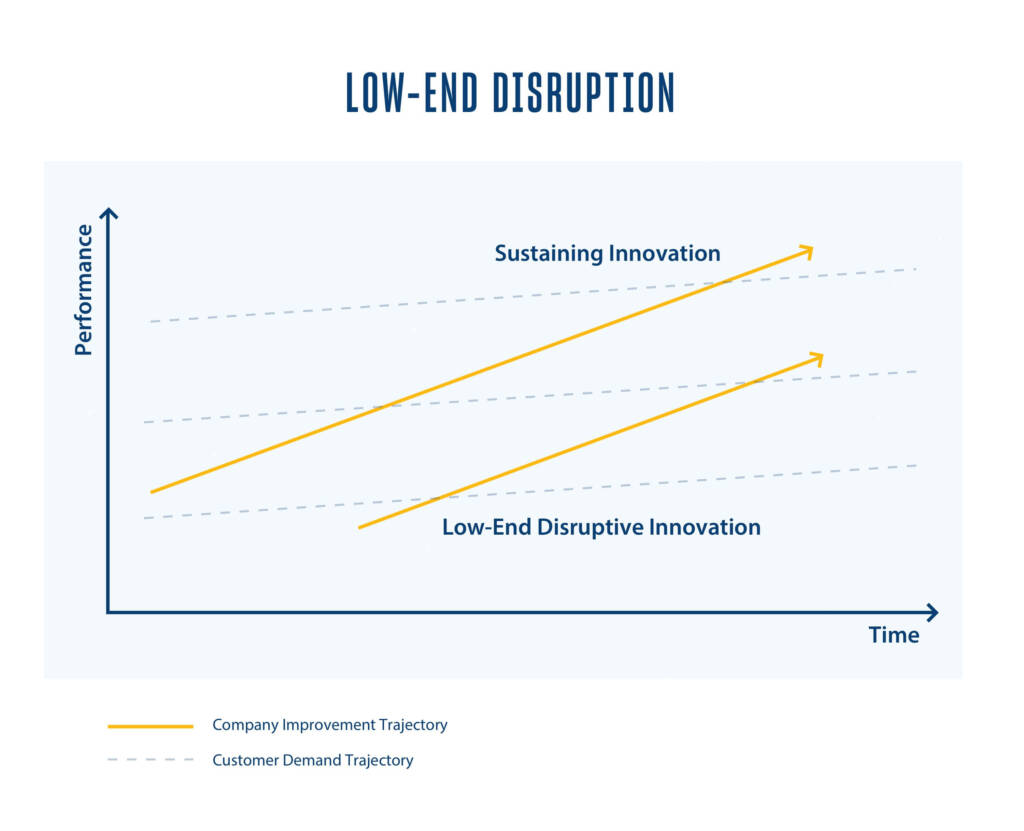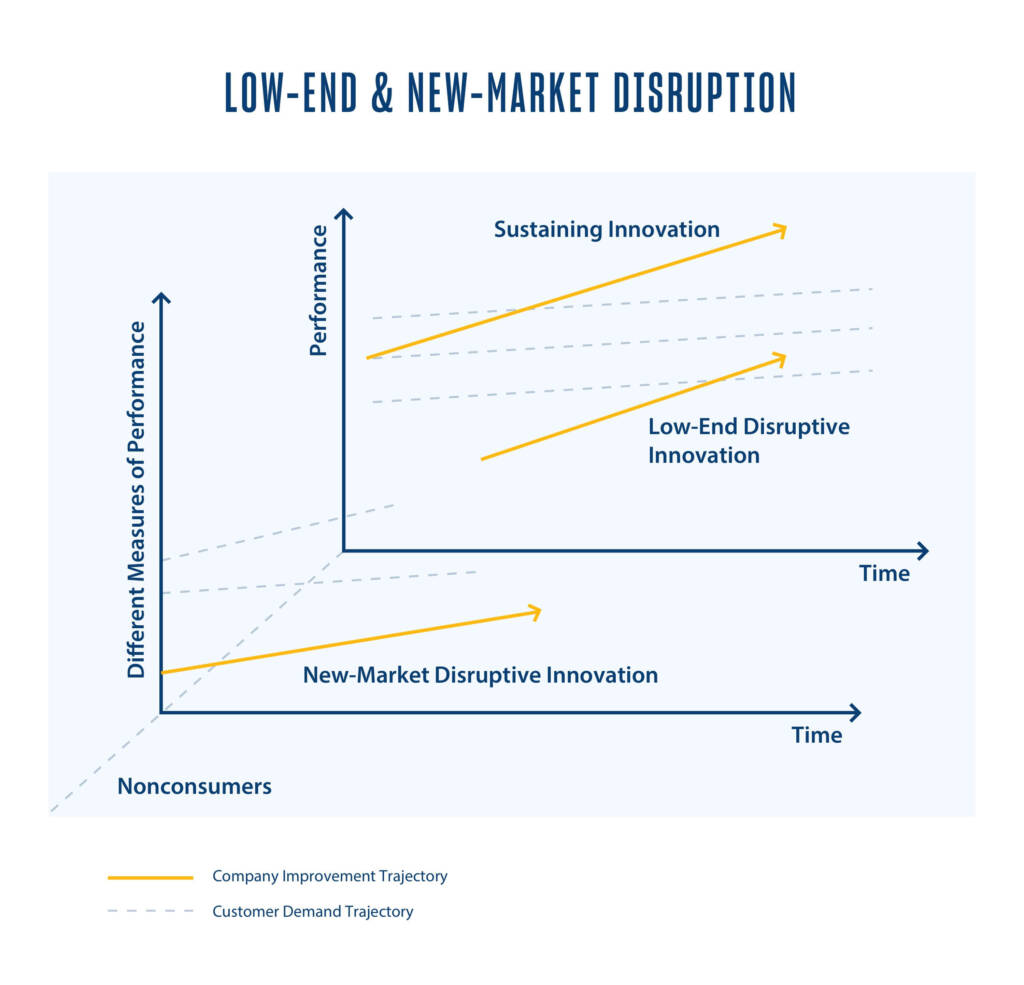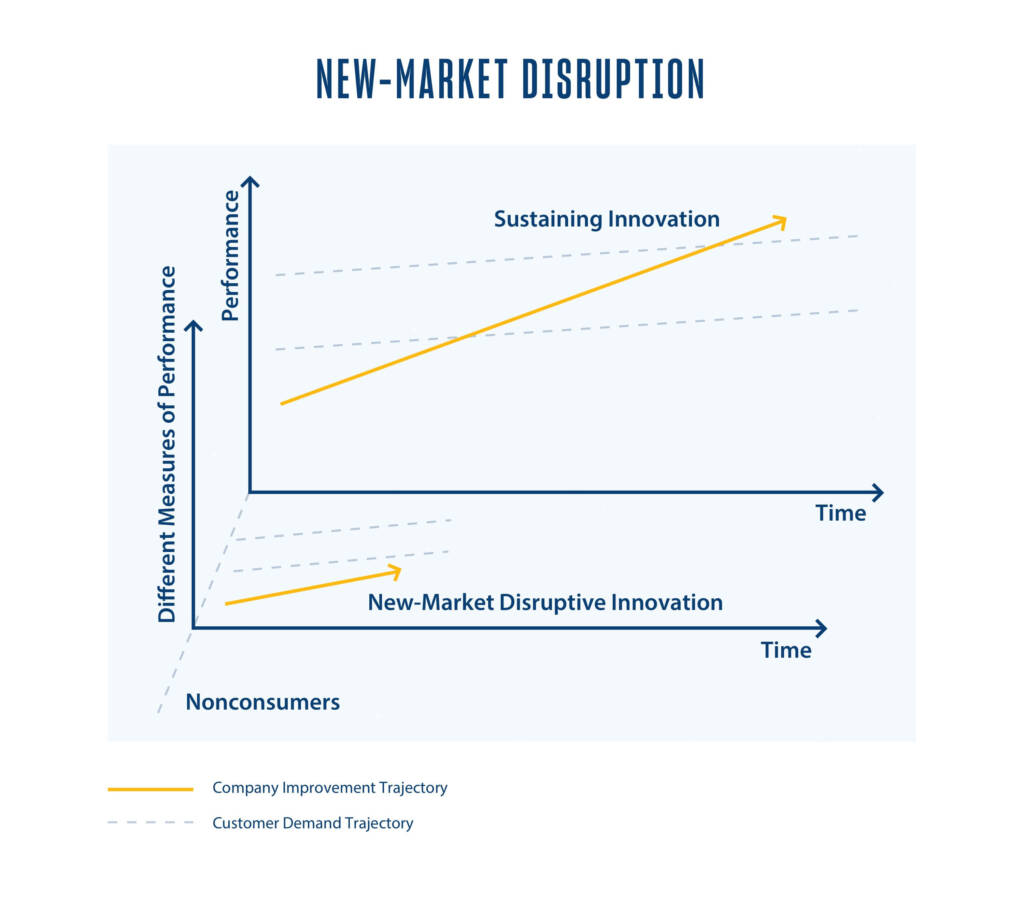Of all the modern business concepts to have been coined over the last few decades, disruptive innovation may be the most influential, the most hyped and the most misunderstood. It can feel like we’ve been talking about “industry disruptors” for years now, in every industry from technology to healthcare, retail, finance and beyond. Even your pizza delivery is held up as an example of disruptive innovation.
The term has been enormously influential in business circles, favored by CEOs, consultants, venture capitalists and all the aspiring entrepreneurs looking to be the next great disruptor. The term is so pervasive and established that The Economist called disruptive innovation “one of the most influential modern business ideas” in one of their quarterly reviews of business books.
However, the theory has also been widely misunderstood, and the “disruptive” label has been carelessly applied anytime a market newcomer shakes up well-established incumbents or claims how their new product will disrupt a market or industry. True disruption is a process, and by understanding how that process works, in coordination with the right skills and knowledge, an entrepreneur can formulate and execute a winning strategy to truly succeed in a market.
What Is Disruptive Innovation?
The term disruptive technologies was coined by Clayton M. Christensen in his 1995 article Disruptive Technologies: Catching the Wave, in which he identifies technology innovations as key disruptors for industry. Christensen later reconceptualized the term as “disruptive innovation” because he recognized that it wasn’t so much about the thing itself but the business model that acts as the disruptive vector.
Essentially, the disruption innovation model significantly alters the way that an industry or business operates to make a product or service more accessible and/or affordable to a wider audience. That market expansion leads to a shift over time where the disruptor comes to either directly challenge the established dominant brands, forces them to adapt or renders them obsolete.
Here’s how the process of disruptive innovation works:
- Established companies within an industry pursue “sustaining innovations” — improvements on existing products and services — to service the higher tiers of their market, as that model brings them the greatest profitability.
- Their research and development is dedicated to iterations on those existing products and services in order to cater to their most sophisticated customers.
- This strategy does not account for potential customers at the lower tiers of the market who either do not have access to the product or service, can’t afford it or have no use for it.
- This vacuum leaves room for new companies to develop “disruptive innovations” to appeal to the bottom of that market.
- One of those disruptive innovations successfully provides convenient and affordable access to that product or service, connects with a wider number of customers and then grows to the point where it takes up more of the market.
Not every disruptive innovation will succeed — in fact, most won’t — but those that do have the potential to fundamentally change an industry or even create an entirely new one.
Characteristics of Disruptive Innovation
In a clarifying article published by Harvard Business Review, Christensen himself wrote that “Many researchers, writers, and consultants use ‘disruptive innovation’ to describe any situation in which an industry is shaken up and previously successful incumbents stumble. But that’s much too broad a usage.” There are specific characteristics of disruptive innovation that can help identify the real deal:
- Disruption is a process, which means that the disruption is not the product or service itself. Anyone who’s pitching a product they claim is going to disrupt an entire industry and become the next Google/Apple/Uber is — to put it mildly — blowing smoke. Truly disruptive innovation can’t be measured in instantaneous value, because there is none. It’s only by the “sum over histories” of the innovation’s market behavior that determines if it was disruptive.
- Part of what makes disruptive innovations so difficult to identify is how they start off at very low margins — often at the very edges of a market. It’s only if (and that’s a rare if) the innovation goes mainstream that it enjoys exponential growth.
- Part of the reason why disruptive innovations start in the margins is that they begin as very small-scale experiments. It’s smaller, more agile teams that are more likely to create disruptive innovations that will appeal to those margins because they don’t need that much of a return in order to succeed. It’s self-defeating for large teams to try for those margins, because there’s no guarantee of a return to be worth the investment.
- As a result, disruptive innovations tend to be produced by startups run by outsiders and ambitious entrepreneurs. Existing market-leading companies are too invested in promoting “what works” over trying to disrupt their own market, which is why their focus is on sustaining innovations. Disruptive innovations take longer to develop and the risks associated with them are much higher.
Disruptive Innovation Models for Entrepreneurs
Because every market is different and they’re all in a constant state of flux, it’s not easy to apply lessons from successes or failures of individual innovations. There are general tips that you can follow about how to develop and market a product or what you need to do to start a business — but it’s not as simple to understand “how to disrupt an industry.”
If you’re an aspiring disruptive entrepreneur, the most important thing to understand — and decide on — is where your market exists. A truly disruptive innovation starts from one of two footholds: the low-end market or in new markets.
Low-end markets exist because established companies typically try to appeal to their most profitable and demanding customers and they pay less attention to less demanding customers. While that leaves a little bit of room at the bottom of the market, the inevitable truth is that, as these companies continue to introduce higher quality products or services to satisfy the higher end of the market, they increasingly over-shoot the lower end and start to leave many mainstream customers behind. Christensen called these “overserved customers” because their product choices are generally beyond the capabilities they need, but they continue to purchase anyway, since they have no realistic alternatives.

The opening for low-end disruptors is to introduce “good enough” products that meet basic functionality, but cut out the excess features. Entrants who establish footholds in the lower end of the market and find success there can improve their performance over time and grow their own customer base. Eventually they may move up market to claim more of the mainstream and even challenge the established companies’ dominance.
Disruptors can alternatively establish a new-market foothold by finding a way to turn non-consumers into consumers. Rather than competing for an existing company’s customers, the disruptor appeals to those who are unable to purchase or access the product or service by offering something that is more accessible, simpler to use or just costs less. In some cases, these former non-consumers can grow to represent a larger market segment.
Christensen called these “underserved customers” because market alternatives are effectively too expensive, complicated or generally beyond the price/capabilities they could justify. Drawing new customers from outside the existing market participants allows disruptors to “sneak up” on incumbents since they are not intimate with this customer segment. The focus by established companies on appealing to the higher end of their existing market effectively leaves them blind to the spaces around them.

Understand that when brands ignore these segments below or outside their established markets, it isn’t necessarily an oversight, but just established “good business.” To succeed at the lower ends or in new markets requires getting by on lower returns and less revenue. Established businesses often explore expanding into these areas, but what they find is that the initial efforts won’t be worth their time or investment, and so will usually cancel the initiative. Disruptors don’t have the same growth and revenue demands, and so are able to find success with smaller markets.

Examples of Disruptive Innovation
Considering the above characteristics, some specific disruptive innovation examples include:
- Smartphones — But not necessarily how you might think. The move from simple mobile and PDAs to smart phones is really more of a sustaining innovation, where an existing product is further developed to appeal to the higher end of the market. The disruptive element of smartphones comes from how they presented an alternative to desktop computers and laptops. Suddenly, applications that were only available behind expensive and bulky tech could be more affordable and more accessible.
- Downloadable digital media — The closest many of us come to using physical media these days are portable hard drives, notwithstanding a classic vinyl record if you’re an audiophile. But, it wasn’t that long ago when all media was only available in hard copy. But just as streaming companies like Netflix gradually replaced Blockbuster’s model of physical video tape rentals, today’s tech companies are all in on Software-as-a-Service business models. This is as much a change in cost as in the technology, as downloadable services operate on subscription-based accounts instead of one-off purchases.
- Digital photography — There was a time when photography was limited to hobbyists or professionals who could spare the time, space and expense to develop film through a chemical process in darkrooms. Both easier-to-use digital cameras and smartphones brought photography to the masses, to the point where former industry giant Eastman Kodak not only had to declare bankruptcy, but switched their operations over to the digital imaging market (though they still do provide film to Hollywood studios).
- Online learning — Sometimes it’s outside factors that completely disrupt a market. While institutes of higher education have offered online learning for years, it was often seen as secondary or only supplementary to an on-campus education. The implementation of online learning also lagged behind in K-12 grades, largely due to the lack of infrastructure and budget for public schools. The COVID-19 pandemic served as an accelerating event, forcing the market to look toward online and remote learning to continue. Now, in the aftermath, the value of online learning is more widely recognized and is settling in an equal standing to traditional higher education.
- Ride sharing — Though Uber and similar ride share programs are often considered as alternatives to the taxi, that would not technically qualify as a disruptive innovation. Taxis aren’t overly expensive and the majority of people who would use a rideshare would also consider using a taxi, so ride sharing really isn’t a new market or low-end disruption. However, it could be considered as a disruptive innovation in the limousine and high-end transportation market — offering on-call services for those customers who might not have been able to afford a limousine service.
Other examples of disruptive innovations include the mass produced automobile, electricity service, television, blockchain technology and GPS systems.
Useful Tips for Disruptive Entrepreneurship
Remember that not every disruptive innovation succeeds. While the successes get a lot of headlines and are held up as exciting examples of entrepreneurship, the disruptive path is just as likely to end in failure. So, take caution with any advice that purports to show you how to disrupt an industry.
However, if you’re excited by the prospect of disruptive entrepreneurship, there are some recommended ways to go about it:
- Study existing markets and their customers to determine where on the margins there might be an opportunity to introduce something new:
- Can you offer something that is cheaper or easier to use than what’s currently available? Then you may have a chance for low-end market disruption.
- Have you identified an appeal to customers who have previously gone without a product? Then you may be able to create an entirely new market.
- Don’t get hung up on trying to create a physical product. Services are as much a process by which new business models can capture overlooked markets or create new ones.
- Remember that the disruption process works because it operates at lower profit margins. If your company can’t get by at lower operating costs, then you’re likely not going to last very long. Also, as soon as you reach a point where your profit margins start to challenge those of an established business’ products, then they’re going to take notice — and you don’t want to fight them for market share.
- Understand that you’re competing not just against established companies, but against other would-be disruptors. There are other startups looking to establish a foothold in both the low-end and new markets with products that are simpler, more convenient or less costly than those sold by incumbents. How are you going to beat them to market, compete for the same customers and out-perform them?
There’s a lot that goes into this process, and no small amount of luck. Aspiring engineers and innovators need the skills and knowledge to develop insights into what spurs customers’ actions and how they make buying decisions. If you want to succeed, then you need to be able to identify industries or segments ripe for disruption and quickly determine how you’re going to meet the right product-market fit.
We designed the University of San Diego’s Master of Science in Innovation, Technology and Entrepreneurship to examine the innovative and entrepreneurial possibilities of today’s electronic communications and advancing technology. If you’re looking to hone your instincts for which areas are ripe for innovation and disruption, then we invite you to explore USD’s MITE degree program to see how you can get started.




